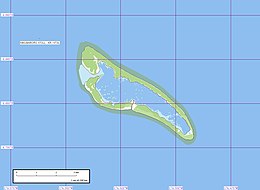Nikumaroro

Geographical map of Nikumaroro
|
|
| Geography | |
|---|---|
| Coordinates | 4°40′48″S 174°31′01″W / 4.68°S 174.517°WCoordinates: 4°40′48″S 174°31′01″W / 4.68°S 174.517°W |
| Archipelago | Phoenix Islands |
| Length | 6 km (3.7 mi) |
| Width | 2 km (1.2 mi) |
| Administration | |
| Phoenix Islands Protected Area | |
| Demographics | |
| Population | 0 |
Nikumaroro, or Gardner Island, is part of the Phoenix Islands, Kiribati, in the western Pacific Ocean. It is a remote, elongated, triangular coral atoll with profuse vegetation and a large central marine lagoon. Nikumaroro is approximately 7.5 kilometres (4.7 mi) long by 2.5 kilometres (1.6 mi) wide. There are two narrow entrances through the rim, both of which are blocked by a wide reef which is dry at low tide. The ocean beyond the reef is very deep and the only anchorage is at the island's west end, across the reef from the ruins of a mid-twentieth-century British colonial village, but this is safe only with the southeast trade winds. Landing has always been difficult and is most often done south of the anchorage. Although occupied at various times during the past, the island is uninhabited today.
Kiribati declared the Phoenix Islands Protected Area in 2006, with the park being expanded in 2008. The 425,300-square-kilometer (164,200-square-mile) marine reserve contains eight coral atolls including Nikumaroro.
Nikumaroro has been the focus of considerable speculation and exploration as a location where pilot Amelia Earhart might have crashed in July 1937 during her ill-fated final flight, attempting to circumnavigate the globe.
Thick scrub and Pisonia forest cover the land surface. The trees grow 15 meters (49 ft) in height and result in decomposing leaf material in the soil. Coconut palms remain from the attempts to operate a plantation on the island from 1893 to 1894 and 1938 to 1963.
The scarcity of fresh water on Nikumaroro has proven problematic for residents in the past, and contributed directly to the failure of a British project to colonize the island from 1938 to 1963.
Nikumaroro is sporadically visited by biologists attracted to its extensive marine and avian ecosystems. The atoll has a large population of coconut crabs. Migratory birds and rats abound. Several species of shark and bottlenose dolphins have been observed in the surrounding waters.
...
Wikipedia
